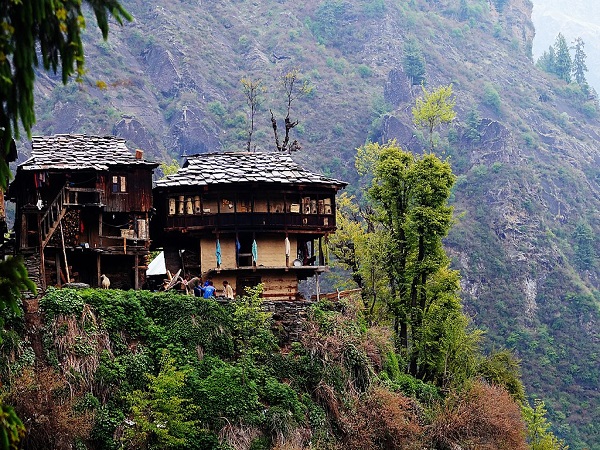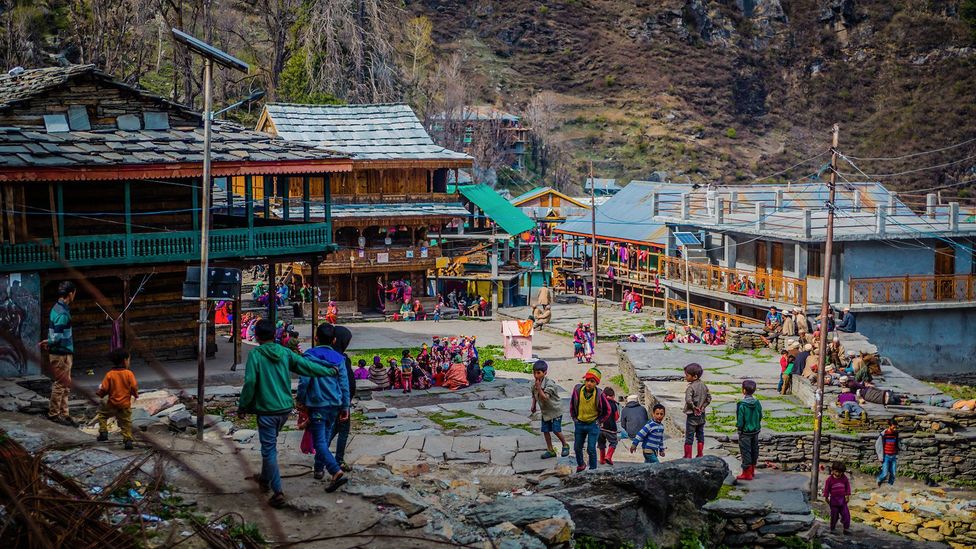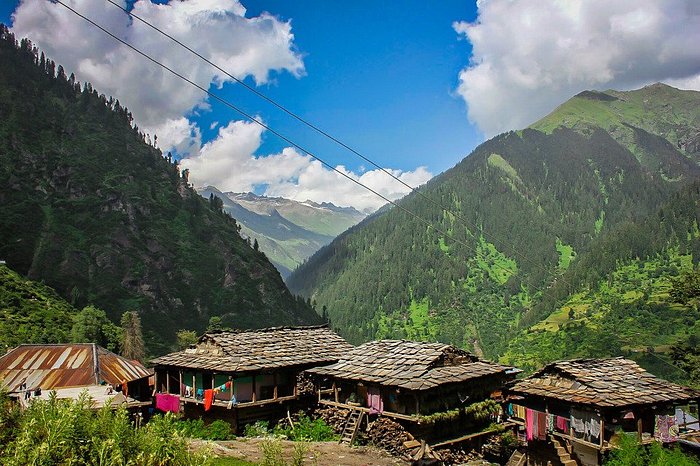
Malana:- A Fascinating Village in the Parvati Valley

The Parvati Valley of Himachal Pradesh, India, lies a small but unique village called Malana. This village is known for its distinctive culture, traditions, and history, making it a must-visit destination for tourists looking for something out of the ordinary.
Malana is considered one of the oldest democracies in the world, with a unique system of self-governance that has been in place for centuries. The village is home to the Malana people, who are believed to be the descendants of Alexander the Great’s army. The locals are proud of their heritage and maintain their culture, language, and traditions despite the growing influx of tourists in recent years.
One of the most interesting things about Malana is the legal system that they follow. The village has its own set of rules and regulations that are enforced by the village council. The council consists of seven members who are elected every two years by the village community. The council members have the power to make and enforce laws, as well as settle disputes among the villagers.
The architecture of the village is another highlight of Malana. The houses in the village are built using stone and wood, and they have a unique design that is different from other villages in the region. The houses are built close to each other, and the narrow alleys between them create a maze-like structure.
Malana Village Secrets
Here are ten of Malana’s most fascinating secrets:
Self-Sustaining Lifestyle: The villagers of Malana rely on agriculture and animal husbandry for their livelihood. They grow crops such as barley, wheat, and cannabis, and rear sheep and goats for wool and meat. The village is also known for its production of high-quality hashish, which is illegal in India.
Unique Language: The Malanis speak Kanashi, a language that is different from other regional languages. They use Kanashi in their daily lives and consider it an essential part of their culture.
Strict Caste System: The village is divided into five clans, and each clan has its unique duties and responsibilities. The villagers follow their customs and rituals religiously, and the Kanishtha Sangh, a council of elders, governs the village.
Belief in Deities: The Malanis have a unique belief system that revolves around their deities, Jamlu Devta and Renuka Devi. They offer sacrifices to Jamlu Devta to bring good luck and prosperity and consider the cannabis plant a gift from the deity.
Fagli Festival: The Fagli festival, celebrated in February. During this festival, the villagers wear traditional costumes, perform folk dances and songs, and offer prayers to their deities.
No Touching: The villagers of Malana do not allow outsiders to touch their homes or belongings. They consider it impure and believe that it will bring bad luck.
Different Laws: The village has its unique legal system, and outsiders must follow their rules and regulations while in the village. The villagers do not allow anyone to take photographs or videos without their permission.
Hospitality: Despite their strict laws and customs, the Malanis are hospitable people and welcome visitors to their village. They offer their guests food and shelter and share their stories and traditions.
No Inter-Caste Marriage: The villagers do not allow inter-caste marriage and consider it a taboo. They believe that it will bring disgrace to their clan and the village.

Malana Village Rules:-
Malana village is governed by its own set of rules, which have been passed down through generations and are strictly enforced by the locals. Malana village has strict rules that everyone must follow.
1. Outsiders are not allowed to touch anything in the village.
2. Visitors must seek permission before taking photographs or videos.
3. Inter-caste marriages are not allowed.
4. The villagers follow a strict caste system.
5. They have their unique legal system.
6. The village has its own deity, Jamlu Devta, who is revered by the villagers.
7. Sacrifices are offered to the deity during festivals and special occasions.
8. Cannabis cultivation and hashish production are the main sources of income for the villagers.
9. The villagers are hospitable but expect visitors to respect their customs and traditions.
10. Kanashi is the language spoken by the villagers and is an essential part of their culture.
In summary, Malana village has strict rules that outsiders must follow, and the villagers have maintained their unique culture and traditions. The village’s strict caste system, belief in their deity, and reliance on cannabis cultivation and hashish production have contributed to its fascinating culture and lifestyle
Lifestyle and Culture:-
The village has a unique culture and lifestyle that is distinct from the rest of the region. The people of Malana, known as Malanis, are proud of their heritage and have preserved their customs and traditions for centuries.
The village is home to around 2000 people, who live in stone houses with wooden balconies and slate roofs. The Malanis follow a strict caste system, which divides the village into five clans, each with its unique duties and responsibilities. The village has a council of elders, known as the Kanishtha Sangh, which governs the community.
The Malanis are known for their self-sustaining lifestyle and their belief in the supernatural. They rely on agriculture and animal husbandry for their livelihood. And each family owns a patch of land where they grow crops such as barley, wheat, and cannabis. The villagers also rear sheep and goats for their wool and meat.
The Malanis have their language, Kanashi, which is distinct from Hindi and other regional languages. They also have their customs and rituals, which they observe strictly. One of the most significant festivals of Malana is Fagli, which is celebrated in February. During this festival, the villagers wear traditional costumes, perform folk dances and songs, and offer prayers to their deities.
The Malanis have a unique belief system that revolves around their deities, Jamlu Devta and Renuka Devi. They believe that Jamlu Devta is the protector of the village and the one who provides them with prosperity. They offer him sacrifices, which they believe bring them good luck and fortune.
The Malanis are also known for their production of high-quality hashish, which is illegal in India. However, the villagers have been growing cannabis for generations. It is an integral part of their culture and economy. They believe that the cannabis plant is a gift from Jamlu Devta and use it for medicinal and religious purposes.
Malana Cream uses
“Malana Cream” is a type of cannabis resin that is produced in the village of Malana in Himachal Pradesh, India. The resin is derived from locally grown cannabis plants and is known for its high potency and distinct flavor. While the use and possession of cannabis is illegal in India. Malana Cream has gained a reputation for its medicinal properties. And is often used to treat a variety of ailments such as chronic pain, anxiety, and insomnia. However, it is important to note that the use of Malana Cream is illegal and can have serious legal and health consequences.
The Weather in Malana: A Beautiful Escape
Malana is a picturesque village located in the Parvati Valley of Himachal Pradesh, India. The village is situated at an altitude of 2,652 meters and is surrounded by majestic mountains. The weather in Malana is pleasant throughout the year, making it an ideal destination for nature lovers.
During the summer months, from March to June, the weather in Malana is mild and comfortable. The average temperature during this time ranges between 10°C to 25°C. The days are warm, and the nights are cool, providing the perfect weather for outdoor activities like trekking and hiking. The clear skies and cool breeze make it an excellent time to explore the beauty of the surrounding hills.
The monsoon season in Malana starts in July and continues until September. During this time, the village receives moderate to heavy rainfall, making the weather humid and wet. However, the rain adds to the charm of the village, and the lush greenery that surrounds the village becomes even more enchanting. The village is enveloped in a dense fog, which creates a mystical atmosphere that is perfect for introspection and relaxation.
From October to February, Malana experiences winter, with the temperature ranging from 2°C to 10°C. The village is covered in snow during this time, and the weather becomes quite cold. However, the snowfall adds a magical touch to the village, making it an ideal destination for winter sports like skiing and snowboarding. The village takes on a fairy-tale-like atmosphere, with snow-covered rooftops and smoke rising from chimneys.
The winters in Malana Village are cold and snowy, with temperatures dropping to as low as -5°C. Malana offers a pleasant and moderate climate all year round, with each season having its unique charm and appeal. Whether you’re looking for a summer escape, a monsoon retreat, or a winter wonderland, Malana is the perfect destination for nature lovers and adventure seekers alike.
How to Reach Malana Village
Malana is a remote village located in the Kullu district of Himachal Pradesh, India, and is accessible only on foot. Malana to Kasol is 22kms. The nearest road is about 20 km away from the village, and visitors have to trek through the mountains to reach Malana. Here’s how to reach Malana:-
By Air:
The nearest airport to Malana is the Kullu-Manali Airport, which is located about 50 km away from the village. From the airport, visitors can hire a taxi to reach Jari, which is the nearest road to Malana.
By Road:
The nearest road to Malana is located in Jari, which is about 20 km away from the village. Visitors can take a bus or hire a taxi from Kullu, Kullu to Malana the distance is 48km. Manali or Bhuntar to reach Jari. From Jari, visitors have to trek for about 3-4 hours to reach Malana.
It is important to note that the trek to Malana can be challenging, and visitors should be prepared for a steep climb through rugged terrain. Visitors are advised to wear comfortable trekking shoes, carry enough water, snacks, dress appropriately for the weather.





